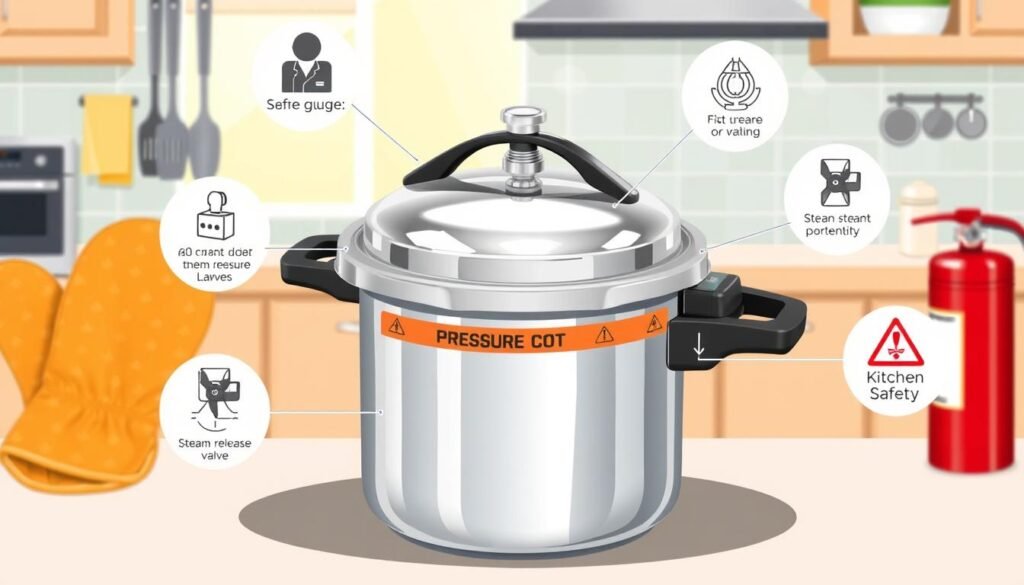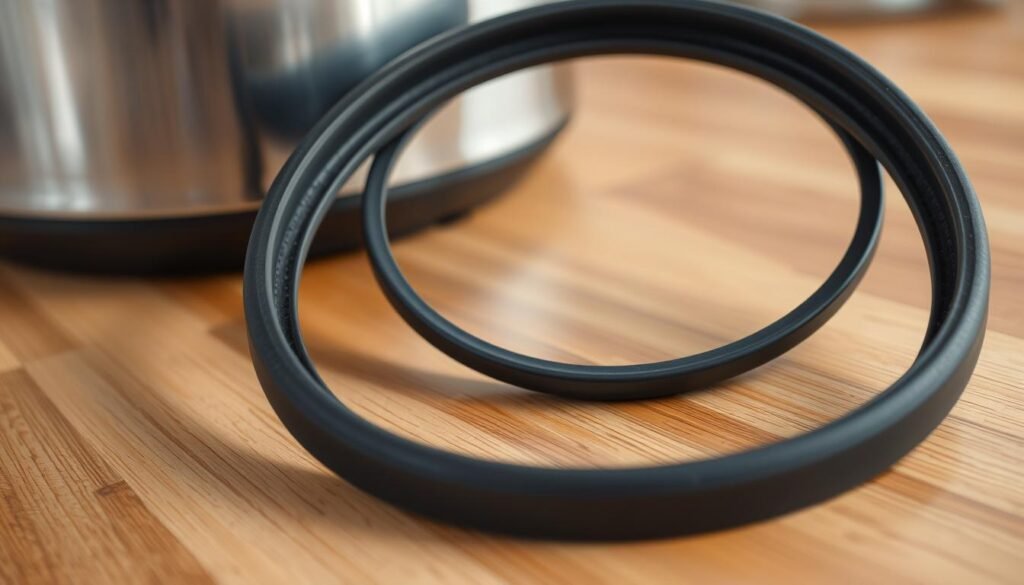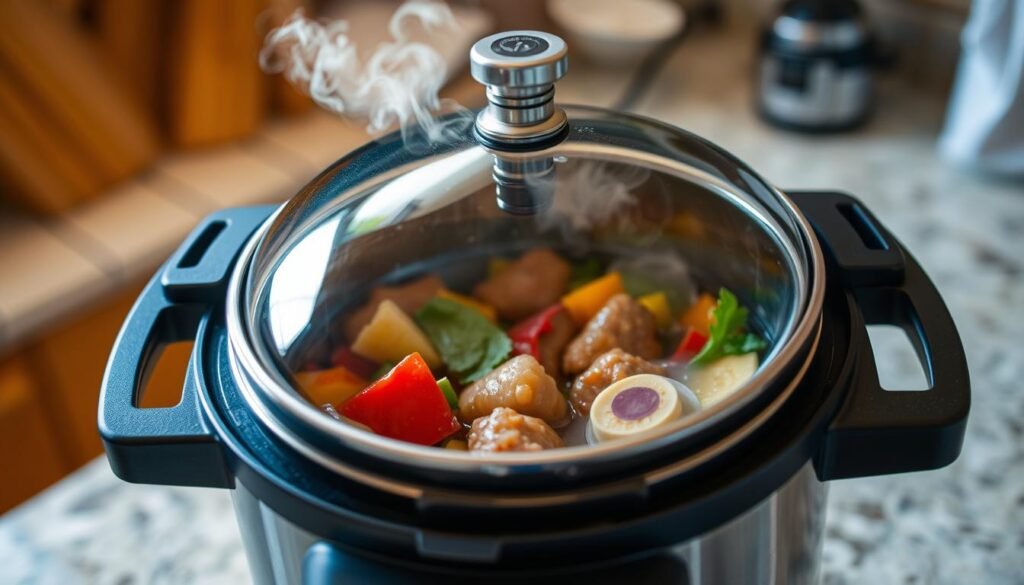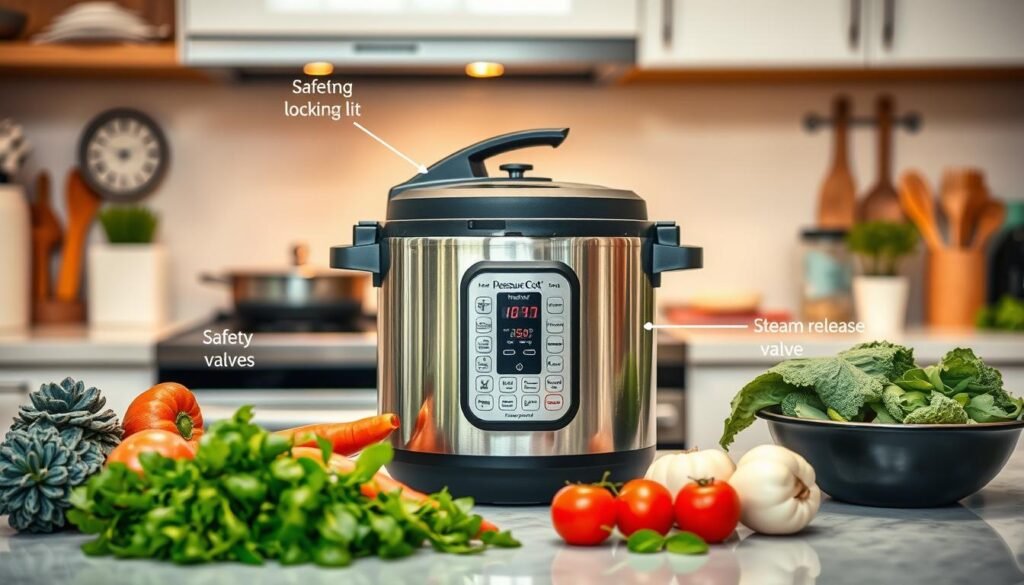Did you know that many pressure cooker explosions are caused by manufacturing defects and design issues? This shows how important quality control is in the industry1. These explosions can lead to serious injuries like steam burns, contact burns, and injuries from the explosion itself1. It’s vital to know the risks and take steps to stay safe in the kitchen.
Key Takeaways
- Pressure cooker explosions can cause severe injuries, including steam burns, contact burns, and injuries from the explosion itself.
- Manufacturing defects and design issues are common reasons for pressure cooker explosions, highlighting the need for quality control.
- Faulty gaskets can lead to premature opening of the pot during high pressure, indicating the importance of regular gasket maintenance.
- Inadequate venting is a major risk factor for pressure cooker explosions, underscoring the necessity for proper venting mechanisms.
- Following recommended safety guidelines, such as replacing the gasket regularly and not overfilling the cooker, can help prevent accidents.
Understanding Pressure Cooker Explosions
Pressure cooker explosions are serious hazards. They can happen for many reasons. Issues like bad lid seals, faulty gaskets, and not enough venting can cause them2.
These problems can lead to steam and hot contents bursting out. This can cause severe burns, scalds, and other injuries2.
Causes of Pressure Cooker Explosions
Pressure cookers can explode for a few reasons. Being overfilled, using the wrong oil, and clogged vents are common causes2. Over the years, manufacturers have made them safer.
Now, they have electric heat sources and better pressure control3. But, older or poorly made pressure cookers are a risk. They need regular care and use as the maker says3.
Potential Injuries from Pressure Cooker Accidents
Injuries from a pressure cooker explosion can vary. They can be minor or very serious. Burns, from first to third degree, and trauma from the explosion are possible2.
Some brands, like Tristar Power Pressure Cooker XL and InstaPot, have had incidents2.
Even though pressure cookers are safer now, it’s key to use them right. Following the maker’s guidelines can prevent explosions and injuries3. Being careful and following safety tips can make cooking with them safe and enjoyable4.
Common Defects in Pressure Cookers
Pressure cookers make cooking faster by heating food quickly under high pressure. But, they can be dangerous if they have defects5. Problems like bad seals, blocked vents, or faulty safety valves can cause explosions5. These explosions can lead to serious injuries, from burns to cuts5.
If someone gets hurt by a faulty pressure cooker, they might be able to sue for damages5.
Inadequate Lid Seals
One big problem with pressure cookers is bad lid seals5. If the seal doesn’t work right, it can lead to accidents5. A bad gasket can cause the cooker to explode, leading to serious injuries5.
These injuries can include burns, brain damage, cuts, eye problems, hearing loss, disfigurement, fractures, and even mental trauma5.
Faulty Gaskets that Allow Premature Opening
Bad gaskets in pressure cookers can also be a safety risk6. Other common problems include faulty lid locks and loose or bad pot seals6. A bad gasket can make the cooker explode, causing serious harm5.
Because of these defects, many people get hurt each year, leading to lawsuits6.
Inadequate Venting
Another big issue is when pressure cookers don’t vent properly5. If the steam vents are blocked, it can be very dangerous5. Bad steam release valves can also cause problems5.
When pressure cookers don’t vent well, pressure builds up, which is very dangerous5.
Defects in pressure cookers can be very dangerous for users567. Companies must check their products to keep people safe7. If a cooker is found to be defective, people can sue for their injuries7.
Pressure Cooker Blows Up: Safety Precautions
If a pressure cooker suddenly explodes, it’s vital to act fast to stay safe8. Such explosions can cause severe burns, cuts, and even permanent damage8. You might also face brain injuries, blindness, or electric shock8. Healing from these injuries could take a lot of time and therapy8.
First, cover your face, hands, and body from the hot steam and contents9. Don’t open the lid right away. Instead, follow the maker’s guide to release pressure safely9.
Some well-known brands like Instant Pot and Tristar Power Pressure Cooker have been recalled8. These recalls are due to problems like bad gaskets, faulty seals, and poor ventilation8.
- Protect your face, hands, and body from hot steam and contents during a pressure cooker explosion.
- Carefully follow the manufacturer’s instructions for releasing pressure and opening the cooker.
- Be aware of product recalls and defects that can increase the risk of pressure cooker explosions.
By taking these steps, you can lower the risk of injury and the bad effects of a cooker blowing up9. Always put your safety first in a cooker emergency9.

| Statistic | Value |
|---|---|
| Patients Included in the Study | 32 |
| Gender Breakdown | 29 females, 3 males |
| Average Patient Age | 42.3 years (range: 8-83 years) |
| Ocular Injuries | 34.3% of cases |
| Ear Injuries | 6.25% of cases |
| Average Hospital Stay | 10.5 days (range: 2-37 days) |
| Explosions Due to Product Issues | 15.6% of cases |
| Explosions Due to User Error | 81.2% of cases |
| Mortality Rate | 0% |
This data shows the dangers of pressure cooker explosions and the need for more safety awareness9. Knowing the causes and effects helps us prevent these incidents and stay safe9.
“Pressure cooker explosions can have devastating consequences, but by following safety protocols, we can minimize the risks and ensure a safe cooking experience.”
Being careful and following the maker’s rules are key to keeping your pressure cooker safe8. Taking the right steps can protect you and avoid big problems8.
Inspecting Your Pressure Cooker Before Use
As a home cook, it’s important to check your pressure cooker before using it. This step helps avoid accidents and keeps you safe in the kitchen10.
Checking the Gasket
The gasket, or sealing ring, is key for a tight seal in your pressure cooker. Look for cracks, dryness, or damage on this rubber seal10. If it’s worn or damaged, replace it right away10.
Replacing the Gasket Regularly
It’s best to replace the gasket every year, or sooner if you use it a lot10. This keeps the seal strong and prevents pressure buildup or explosions11.
| Gasket Inspection Checklist |
|---|
|
Regularly checking and replacing the pressure cooker gasket lowers the risk of explosions. It also keeps your appliance safe to use11.

Proper Filling and Liquid Usage
Using a pressure cooker right means following the filling and liquid rules. Too much in the cooker can be dangerous. It stops food from venting and builds up too much pressure12. So, fill it no more than two-thirds full. For foods like beans, rice, or pasta, fill it only halfway12.
Avoiding Overfilling
Too much in the cooker can block the vents. This is a big safety risk12. Always leave room for food to expand and steam to escape13. Stick to the max fill line your cooker suggests for safety13.
Using Enough Liquid
Right liquid amount is key for the cooker to work well13. You need at least half a cup of liquid for steam12. Not enough liquid can cause long cooking times and damage13.
Keep the right amount of food and liquid for safe and efficient cooking1213.

“Using the right amount of liquid and not overfilling the pressure cooker is key for safe and efficient use.”
Food Safety in Pressure Cookers
When using a pressure cooker, it’s important to think about the food you’re cooking. Foods like pasta, split peas, and oatmeal can create froth. This froth might block the cooker’s steam valves and vents14. Make sure your recipe fits your cooker’s size and don’t overfill it14.
Also, don’t try to fry food in a standard pressure cooker. Frying can harm the gasket and other important parts14. To keep your cooker safe and working well, don’t fry in it14.
Considering Food Types
- Pasta, split peas, oatmeal, applesauce, and cranberries can produce froth that can clog steam valves and vents.
- Ensure recipe size is appropriate for your pressure cooker and avoid overfilling.
No Frying in Standard Pressure Cookers
Standard pressure cookers aren’t made for frying. Trying to fry can damage the gasket and other parts14. It’s best to avoid frying in a pressure cooker to keep it safe and working right14.
| Food Type | Potential Issues in Pressure Cookers |
|---|---|
| Pasta, split peas, oatmeal, applesauce, cranberries | Can produce froth that can clog steam valves and vents |
| Frying | Not recommended in standard pressure cookers as it can damage gaskets and other parts |

“Pressure cooker explosions can result in permanent scarring on the face, neck, and chest.”15
Knowing which foods can be tricky in pressure cookers and avoiding frying helps keep your appliance safe and working well14. Taking good care of your pressure cooker is key to enjoying its benefits without risks141516.,,
Safe Pressure Release Methods
When your pressure cooker is done cooking, it’s key to release the pressure safely. There are several ways to do this, each with its own benefits and things to consider. It’s important to release the pressure right to avoid accidents and keep you safe.
The natural release method lets the pressure drop slowly, taking 10-30 minutes. It’s good for delicate foods that might get overcooked quickly. But, it’s not ideal for meals where you’re in a hurry. On the other hand, the cold water release method involves putting the cooker under cold running water or in a cold water bath. This makes the pressure drop faster.17
The quick release method is quicker, letting you release the pressure valve manually. This lets the steam out fast. But, you need to be careful to avoid burns. Always point the steam release valve away from you and any nearby surfaces. Use a long-handled spoon or tongs to protect yourself.
No matter which method you choose, be careful of the hot steam when opening the cooker. Pressure cookers can get steam up to 40 degrees hotter than boiling water,18 so you must be careful to avoid injuries like burns, amputations, blindness, concussions, broken bones, and disfigurement18.
By knowing and using safe pressure release methods, you can enjoy your pressure cooker while keeping yourself safe.
Cleaning and Maintenance
Keeping your pressure cooker clean and well-maintained is key for safe and long-lasting use. Always clean the gasket and release valve separately from the rest of the cooker19. This stops food residue or grease from building up and damaging the seal.
To make your gasket last longer, store the lid upside down on the pot19. This keeps it in good shape for your next use.
Gasket and Valve Cleaning
The gasket and release valve are vital parts of your pressure cooker. They need special care when cleaning. Use a soft, damp cloth to clean the gasket, making sure to remove all food particles or debris.
Also, check the gasket for any cracks or wear. If you find any, replace it19. Clean the release valve with a small brush or pipe cleaner to ensure it vents properly.
Proper Storage
Storing your pressure cooker correctly helps the gasket last longer. Place the lid upside down on the pot instead of locking it in place. This keeps the gasket in good condition for your next use.
It’s also wise to store the cooker in a cool, dry place. Avoid direct sunlight or heat sources, as they can damage the gasket and other parts19.
| Pressure Cooker Maintenance Checklist |
|---|
|
By following these easy cleaning and maintenance tips, your pressure cooker will stay in great shape. It will continue to cook safely and reliably for many years1920.
Pressure Cooker Safety Features
Modern pressure cookers have many safety features to avoid accidents. These features are key to keeping these appliances safe. They can get as hot as 130°C (266°F) when sealed21.
Venting and Overpressure Protection
Pressure cookers have backup vents or overpressure plugs. They release extra pressure if the main safety fails. This stops dangerous pressure buildup that could cause an explosion21.
Lid Locks and Pressure Regulators
Many pressure cookers have expanding rubber gaskets. These gaskets keep the lid closed while the contents are under pressure. Pressure regulators also keep the pressure from getting too high, making these appliances safer21.
Pressure cooker safety features are vital to avoid explosions and accidents. These can cause severe burns, electrocution, amputations, and other serious injuries21. But, even with these features, defects can lead to failures2122.
Users must maintain and check their pressure cookers before each use. This ensures the safety features work right. Regular care and attention can reduce the risks of these appliances23.
Conclusion
Pressure cookers are great for quick cooking and keeping food moist and full of nutrients24. But, it’s key to be careful and follow safety rules to avoid accidents and explosions. Knowing the common problems that can cause failures24 helps you check your cooker before using it and keep it clean and stored right.
Even though many U.S. homes have pressure cookers2526, the dangers of pressure cooker explosions and pressure cooker accidents are real. These incidents can cause serious injuries like burns, scarring, disfigurement, and even traumatic brain injuries24. If you’re hurt, getting medical help and maybe looking into legal action for pressure cooker safety compensation is a good step.
By focusing on pressure cooker precautions and using it safely, you can reduce risks and enjoy its benefits. Always be careful, check your cooker, and follow the right ways to fill and release pressure242526. This way, your pressure cooker will stay a safe and useful part of your kitchen.
FAQ
What are the common causes of pressure cooker explosions?
What are the possible injuries from a pressure cooker accident?
What are the most common defects in pressure cookers that can lead to explosions?
What should you do if a pressure cooker blows up?
How do you inspect a pressure cooker before using it?
How do you properly fill and use liquid in a pressure cooker?
What types of foods should be avoided in a pressure cooker?
How do you safely release the pressure in a pressure cooker?
How do you clean and maintain a pressure cooker?
What safety features are found in modern pressure cookers?
Source Links
- Causes of Pressure Cooker Explosions and How to Avoid Them – GUERRA LLP – https://guerrallp.com/product-liability-lawyers/causes-of-pressure-cooker-explosions-and-how-to-avoid-them
- Can Pressure Cookers Explode? – Gainsberg Injury and Accident Lawyers – https://www.gainsberglaw.com/blog/exploding-pressure-cookers-and-what-you-need-to-know/
- How Pressure Cookers Actually Work – https://www.seriouseats.com/how-pressure-cookers-work
- Pressure cooking – https://en.wikipedia.org/wiki/Pressure_cooking
- Defective Pressure Cooker Dangers & Injuries [2024 Guide] – https://www.torhoermanlaw.com/pressure-cooker-explosion-lawsuit/defective-pressure-cooker-dangers-and-injuries-guide/
- What are Examples of Common Pressure Cooker Defects? – Van Law Firm Injury & Accident Attorneys – https://vanlawfirm.com/blog/what-are-examples-of-common-pressure-cooker-defects/
- What Constitutes a Pressure Cooker Defect? | FAQ | Zanes Law – https://zaneslaw.com/faq/what-are-pressure-cooker-defects/
- Pressure Cooker Accidents: Can A Pressure Cooker Explode? – https://www.torhoermanlaw.com/pressure-cooker-explosion-lawsuit/pressure-cooker-accidents-faq-can-a-pressure-cooker-explode/
- Risk of burns in pressure cooker usage: a comprehensive analysis of explosive injuries – https://www.ncbi.nlm.nih.gov/pmc/articles/PMC10977495/
- FSHN22-10/FS446: The Misconceptions about Electric Pressure Cookers – https://edis.ifas.ufl.edu/publication/FS446
- What Happens If Pressure Cookers Are Opened Too Soon? | FAQ – https://zaneslaw.com/faq/what-happens-if-you-open-a-pressure-cooker-too-soon/
- Exploding Pressure Cooker Dangers – https://www.chaffinluhana.com/defective-products/exploding-pressure-cooker-lawsuit/exploding-pressure-cooker-dangers/
- Exploding Pressure Cooker FAQ – https://www.chaffinluhana.com/defective-products/exploding-pressure-cooker-lawsuit/exploding-pressure-cooker-faq/
- PRESSURE COOKER SAFETY – Poser Homestead – https://poserhomestead.com/pressure-cooker/
- The Dangers of Pressure Cookers | Dormer Harpring, LLC – https://www.denvertrial.com/dangers-of-pressure-cookers/
- Why Do Pressure Cookers Explode and When Is It Product Liability? – https://www.hkinjurylaw.com/why-do-pressure-cookers-explode-and-when-is-it-product-liability/
- Pressure Cooker 101: How They Work and Why They Can Explode – the Lithuania Tribune – https://lithuaniatribune.com/pressure-cooker-101-how-they-work-and-why-they-can-explode/
- Instant Pot Explosion Lawsuits | Pressure Cooker Injury Lawyers – https://www.ericratinoff.com/pressure-cooker-explosion-instant-pot-lawsuit/
- Are Pressure Cookers Safe? | Safety Tips & Pressure Cooker Explosions – https://www.consumernotice.org/products/pressure-cookers/
- What Are Possible Pressure Cooker Defects? | FAQ | Zanes Law – https://zaneslaw.com/faq/what-are-the-possible-defects-problems-of-pressure-cooker/
- Pressure Cooker Lawsuits: Instant Pot Explosions Heat Up – https://www.lezdotechmed.com/blog/pressure-cooker-lawsuits/
- Pressure Cooker Explosion Lawsuits | Console & Associates P.C. – https://www.myinjuryattorney.com/national-claims/pressure-cooker-explosion-lawsuits/
- Exploding Pressure Cookers Recalled, Sued for Severe Burns – Harlan Law, PC – https://harlanpc.com/exploding-pressure-cookers-recalled-sued-for-severe-burns/
- Denver Pressure Cooker Explosion Injury Lawyers – The Wilhite Law Firm – https://www.wilhitelawfirm.com/denver/product-liability-attorney/pressure-cooker-explosion/
- Multi-Specialty Care for Second-Degree Pressure Cooker Explosion Burn Injuries | Published in Spartan Medical Research Journal – https://smrj.scholasticahq.com/article/17738-multi-specialty-care-for-second-degree-pressure-cooker-explosion-burn-injuries
- Multi-Specialty Care for Second-Degree Pressure Cooker Explosion Burn Injuries – https://www.ncbi.nlm.nih.gov/pmc/articles/PMC7746041/
